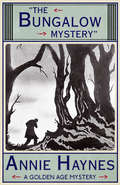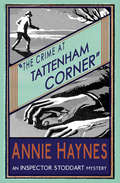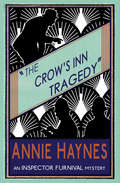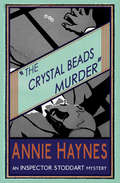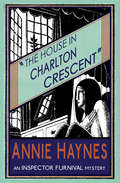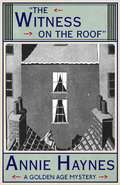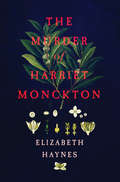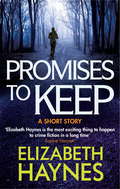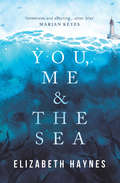- Table View
- List View
The Blue Diamond: A Golden Age Mystery
by Annie Haynes“Who knows if he didn’t make away with her here? Those things found in the Home Coppice show that she was made away with plain enough, I say.” Jim Gregory, under-gardener at Hargreave Manor, finds something unexpected when climbing Lover’s Oak but won’t say what. Instead he’s all ears regarding the legendary ‘Luck of the Hargreaves’ diamonds, destined for the future bride of Sir Arthur, the new squire.Sir Arthur himself then discovers a beautiful stranger, lost in the woods near the manor. She cannot recall a thing—not even her name. She is given shelter and Mary Marston, a private nurse, recognizes her—and abruptly goes missing. Nurse Marston must still be in the house, it is initially agreed—but if so, where?Who got rid of Nurse Marston? To whom does the tobacco pouch with the floral design belong? And why was a blood-stained cuff found in the woods? These mysteries, and more, Superintendent Stokes is determined to solve. The Blue Diamond (1925) is a classic of early golden age crime fiction. This new edition, the first in over eighty years, features an introduction by crime fiction historian Curtis Evans. “Tired men, trotting home at the end of an imperfect day, pop into the library and ask for an Annie Haynes. They have not made a mistake in the street number. It is not a cocktail they are asking for…” Sketch
The Bungalow Mystery: A Golden Age Mystery
by Annie Haynes“He had his tea as usual; when I knocked at the door with the tray (he always had afternoon tea), I found him—like this.” Dr Roger Lavington is dreading his debut performance with the village amateur dramatic society. But real-world drama takes over when Lavington’s neighbour, a reclusive artist, is found murdered in his own sitting room. Also found on the scene are a lady’s glove, a diamond ring, and a mysterious young woman who begs Lavington for his protection. Her safety will depend on her ability to take a role in the forthcoming village play—but is Lavington sheltering a wronged woman or a clever murderess?The Bungalow Mystery (1923) was the first of Annie Haynes’s golden age crime novels, and announced a major talent. This new edition, the first in over eighty years, features an introduction by crime fiction historian Curtis Evans. “The ingredients in this story are skilfully mixed.” Times “Contrived and worked out with considerable craftsmanship—drawn with sympathy and power.”Sunday Times“Contains many cunning devices.” Outlook“The mystery is a real mystery.” Guardian“Plenty of mystery and drama.” Queen“This author has a sure hand at a crime story…strongly recommended to every type of novel reader.” Liverpool Courier
The Crime at Tattenham Corner: An Inspector Stoddart Mystery
by Annie HaynesThe body lay face downwards in a foot of water at the bottom of the ditch. Up to the present it has not been identified. But a card was found in the pocket with the name of –The grisly discovery was overshadowed in the public imagination by Derby Day, the most prestigious event in the English horse-racing calendar. But Peep o’ Day, the popular favourite for the Derby and owned by the murdered man, won’t run now. Under Derby rules, the death means automatic disqualification.Did someone find an ingenious if ruthless way to stop the horse from competing? Or does the solution to the demise of Sir John Burslem lie away from the racetrack? The thoughtful Inspector Stoddart starts to investigate in a crowded field of sinister suspects and puzzling diversions.The Crime at Tattenham Corner was the second of the four Inspector Stoddart mysteries, first published in 1928. This new edition features an introduction by crime fiction historian Curtis Evans.“We not only encounter thrilling surprises but are introduced to many admirably life-like characters. Miss Haynes is here at her best. Excellent as a detective tale, the book is also a charming novel.” Spectator
The Crow's Inn Tragedy: An Inspector Furnival Mystery (Inspector Furnival Mysteries Ser. #Vol. 3)
by Annie Haynes“I cannot understand why Mr. Bechcombe apparently offered no resistance. His hand-bell, his speaking-tube, the telephone—all were close at hand. It looks as though he had recognized his assassin and had no fear of him.”The corner house of Crow’s Inn Square was the most dignified set of solicitors’ chambers imaginable. But this monument to law and order nonetheless becomes the scene of murder - when the distinguished lawyer Mr. Bechcombe, despite giving strict instructions not to be disturbed, is strangled in his own office.Inspector Furnival of Scotland Yard has to wrestle with fiendish clues, unearth priceless gems and tangle with a dangerous gang before he can solve this case, his third and final golden age mystery. Originally published in 1927, this new edition is the first printed in over 80 years, and features an introduction by crime fiction historian Curtis Evans.“What could be better to whet the appetite of the mystery-loving reader? A capital piece of work... exactly the sort of mystery story that everyone is asking for and will eagerly devour.” Sketch
The Crystal Beads Murder: An Inspector Stoddart Mystery
by Annie Haynes“Early this morning a gruesome discovery was made by a gardener employed at Holford Hall in Loamshire...”Robert Saunderson’s murdered body is found in the summer house at Lord Medchester’s country mansion. Some crystal beads, broken off a necklace and found on the scene, form the primary clue. But where is the necklace, and whose could it be?Detective inspector Stoddart and his assistant Harbord have to unravel a mystery that cost two men their lives and destroyed the reputation of others.The Crystal Beads Murder, first published in 1930, was the last of the Inspector Stoddart mysteries, and Annie Haynes’ final book overall. She died, after a long illness, before completing it and it was finished by an unknown friend and fellow writer. This new edition features an introduction by crime fiction historian Curtis Evans.“An uncommonly well-constructed tale…throughout the reader is kept continually on the ‘qui vive’” Western Australian
The House in Charlton Crescent: An Inspector Furnival Mystery (Inspector Furnival Mystery #Vol. 2)
by Annie HaynesProtruding from the dead woman’s breast was the gold and jewelled dagger she had shown them half an hour before. And, looking horribly incongruous among the laces of her fichu, a deep stain was spreading.Elderly cantankerous widow Lady Anne Daventry summons a private detective, Bruce Cardyn, to her London home. He is tasked to find out one thing: just who is trying to kill her? Any number of relations have a financial interest in her death. Then there is Lady Anne’s recently dismissed private secretary, her lady’s maid and the butler…Despite Cardyn’s efforts, Lady Anne is murdered and Inspector Furnival, in his second golden age mystery, is on the case, with Cardyn playing Watson. Originally published in 1926, this new edition is the first printed in over eighty years. It features an introduction by crime fiction historian Curtis Evans.“Miss Haynes’ new book shows all the merits of its predecessors. Careful plot, a villain concealed, natural setting, observation of character—for all these it scores points.” Morning Post.
The Man with The Dark Beard: An Inspector Stoddart Mystery
by Annie HaynesThe note left beside Dr. John Bastow’s corpse simply read: “It was the man with the dark beard.”Dr. Bastow hadn’t approved of his daughter Hilary’s fiancé. So when Hilary’s father is found shot dead inside his own office, the door-key turned from the inside, the fiancé Basil Wilton becomes a chief suspect for Scotland Yard. Yet how could the crime have been engineered?Now an important lacquered box is missing; a former colleague of Bastow’s has suddenly shaved his beard; and the doctor’s ex-secretary has come mysteriously into money. Before Inspector Stoddart of the Yard can form conclusions, another murder takes place, again credited to the “Man with The Dark Beard”…The Man With the Dark Beard is the first of Annie Haynes’ Inspector Stoddart mysteries, originally published in 1928. It is a sparkling lost classic from the early golden age of crime fiction.“Miss Haynes, I think, improves steadily – this is the best detective story she has yet written.” Time and Tide
The Master of the Priory: A Golden Age Mystery
by Annie Haynes“As for books,” Sir Oswald said, “I don’t care for them. Unless I get hold of a good detective story. The tracing out of crime always has a curious fascination for me.” Frank Carlyn quarrelled with his gamekeeper Jack Winter, and then appeared agitated. Soon after, Winter was found shot dead with his own gun. Suspicion was primarily aimed at the late man’s wife, seen rushing to catch a London train, and then vanishing.One year later, the enigmatic governess Elizabeth Martin arrives to take up her duties at Davenant Priory. Her appearance means nothing to the almost-blind Sir Oswald, though others in the household note her dyed dark hair and the smoked glasses she habitually wears. But what is Miss Martin’s secret and how is it connected to the sinister slaying committed twelve months earlier?The Master of the Priory (1927) is a classic of early golden age crime fiction. This new edition, the first in over eighty years, features an introduction by crime fiction historian Curtis Evans.“The story is written so brightly that it almost reads itself.” Eve
The Secret of Greylands: A Golden Age Mystery
by Annie Haynes“There’s no dirty trick he wouldn’t play—it’s my belief that he wouldn’t even stop at murder!” Her husband unmasked as a scoundrel, Lady Cynthia Letchingham seeks refuge at her cousin Hannah’s north-country home Greylands. But on Cynthia’s arrival, she finds Hannah an invalid, having recently suffered a mysterious paralysis; the house is devoid of servants, and Hannah’s husband, charming and sinister by turns, keeps watch over everything and everyone. Only the presence of charming Sybil Hammond and a darkly handsome neighbour relieve the atmosphere for Cynthia - but then a dark red stain appears mysteriously on the sleeve of her coat…What has really happened to Hannah, and the other entangled mysteries along the way, make The Secret of Greylands (1924) an absorbing golden age crime novel matching Wilkie Collins’ high Victorian gothic to the agility of early jazz age fiction. This new edition, the first in over eighty years, features an introduction by crime fiction historian Curtis Evans.“Not only a crime story of merit, but also a novel which will interest readers to whom mystery for its own sake has little appeal.” Nation“Full of thrills and unexpected developments.” Star“A most skilfully written detective story and the mystery is carried through quite brilliantly.” Clarion“A capital story— highly ingenious.” Truth
Who Killed Charmian Karslake?: An Inspector Stoddart Mystery
by Annie Haynes“Owing to the sudden death of Miss Charmian Karslake this theatre is closed until further notice. Money for tickets already booked will be refunded.”Who killed Charmian Karslake, the famous American actress, on the night of the ball at Hepton Abbey? Who was the mysterious Peter Hailsham who had been present at the ball and had since vanished into thin air? What was his connection, if any, with the respectable County family of Penn-Moreton at whose house the murder had taken place?How Inspector Stoddart and his assistant Harbord solve these questions, and the surprising discoveries they make in the course of their investigations, form the basis for one of their most devilish mysteries.Who Killed Charmian Karslake? is the third of Annie Haynes’ Inspector Stoddart Mysteries. First published in 1929, it was out of print for over 80 years until this new edition, which also features an introduction by crime fiction historian Curtis Evans.“A model detective story…a good mental exercise for the distracted reader who has just received his Super-Tax Demand. (The publishers) have again produced a good book.” London Mercury
The Witness on the Roof: A Golden Age Mystery
by Annie HaynesGlancing at her more closely, he noticed dark stains on her white gown. Horror-struck, he bent over her for a moment, and realised that it was unmistakably a corpse. Little Polly Spencer liked to visit her hiding place up on the London rooftops, to escape a scolding or worse from her stepmother. Peeping through a studio window, she sees what looks like a burglary. But signs of robbery are merely a cover for murder - and the young figure on the roof seemingly the only witness to the crime.Polly is sent to live with her well-born mother’s family, her secret kept from the police. More than a decade later, she has become Lady Warchester, the wife of a wealthy titled man—yet, in a world utterly removed from her childhood, she will finally face the pale-faced killer she glimpsed through the window all those years ago. And the danger of having seen too much is about to become acute…The Witness on the Roof (1925) is a classic of early golden age crime fiction. This new edition, the first in over eighty years, features an introduction by crime fiction historian Curtis Evans.“Miss Haynes has a sense of character; her people are vivid and not the usual puppets of detective fiction.” New Statesman
Bakhtin Reframed: Interpreting Key Thinkers for the Arts (Contemporary Thinkers Reframed)
by Deborah J. HaynesVisionary philosopher and literary critic Mikhail Bakhtin (1895-1975) was largely ignored during his lifetime yet his oeuvre has significantly impacted how we think about visual culture. His ideas renewed interest in the word-forming potential of the creative voice and he developed concepts which are bywords within poststructuralist and new historicist literary criticism and philosophy yet have been under-utilised by artists, art historians and art critics. Deborah Haynes aims to adapt Bakhtin's concepts, particularly those developed in his later works, to an analysis of visual culture and art practices, addressing the integral relationship of art with life, the artist as creator, reception and the audience, and context/intertextuality. This provides both a new conceptual vocabulary for those engaged in visual culture – ideas such as answerability, unfinalizability, heteroglossia, chronotope and the carnivalesque (defined in the glossary) – and a new, practical approach to historical analysis of generic breakdown and narrative re-emergence in contemporary art. Deborah Haynes uses Bakhtinian concepts to interpret a range of art from religious icons to post-Impressionist painters and Russian modernists to demonstrate how the application of his thought to visual culture can generate significant new insights. Rehabilitating some of Bakhtin's neglected ideas and reframing him as a philosopher of aesthetics, Bakhtin Reframed will be essential reading for the huge community of Bakhtin scholars as well as students and practitioners of visual culture.
Behind Closed Doors: A Novel (Detective Inspector Louisa Smith #2)
by Elizabeth HaynesTen years ago, fourteen-year-old Scarlett Rainsford vanished without a trace during a family holiday to Greece. When Scarlett is discovered back in her home town after all this time, DCI Louisa Smith is determined to find out what happened to her and why she remained hidden for so long. Was she abducted or did she run away? As Lou and her team delve deeper into Scarlett's past, their investigation throws up more questions than it answers. But as they edge closer to discovering what really went on behind closed doors, the truth is more sinister and disturbing than they had ever imagined.From the bestselling author of Into the Darkest Corner comes an unsettling and compulsively readable novel that will keep you under its spell until the very last page.
Human Remains: A Novel
by Elizabeth HaynesHow well do you know your neighbours? Would you notice if they lived or died? Police analyst Annabel wouldn't describe herself as lonely. Her work keeps her busy and the needs of her ageing mother and her cat are more than enough to fill her time when she's on her own. But Annabel is shocked when she discovers her neighbour's decomposing body in the house next door, and appalled to think that no one, including herself, noticed her absence. Back at work she sets out to investigate, despite her police officer colleagues' lack of interest, and finds data showing that such cases are frighteningly common in her own home town. A chilling thriller and a hymn to all the lonely people, whose individual voices haunt the pages, Elizabeth Haynes' new novel is a deeply disturbing and powerful thriller that preys on our darkest fears, showing how vulnerable we are when we live alone, and how easily ordinary lives can fall apart when no one is watching.
Into the Darkest Corner: A Novel
by Elizabeth HaynesCatherine has been enjoying the single life for long enough to know a good catch when she sees one. Gorgeous, charismatic, spontaneous - Lee seems almost too perfect to be true. And her friends clearly agree, as each in turn falls under his spell. But there is a darker side to Lee. His erratic, controlling and sometimes frightening behaviour means that Catherine is increasingly isolated. Driven into the darkest corner of her world, and trusting no one, she plans a meticulous escape. Four years later, struggling to overcome her demons, Catherine dares to believe she might be safe from harm. Until one phone call changes everything. This is an edgy and powerful first novel, utterly convincing in its portrayal of obsession, and a tour de force of suspense.
The Murder of Harriet Monckton
by Elizabeth HaynesFrom the award-winning and bestselling author of Into the Darkest Corner comes a delicious Victorian crime novel based on a true story that shocked and fascinated the nation.On 7th November 1843, Harriet Monckton, 23 years old and a woman of respectable parentage and religious habits, is found murdered in the privy behind the chapel she regularly attended in Bromley, Kent.The community is appalled by her death, apparently as a result of swallowing a fatal dose of prussic acid, and even more so when the surgeon reports that Harriet was around six months pregnant.Drawing on the coroner’s reports and witness testimonies, Elizabeth Haynes builds a compelling picture of Harriet’s final hours through the eyes of those closest to her and the last people to see her alive. Her fellow teacher and companion, her would-be fiancé, her seducer, her former lover—all are suspects; each has a reason to want her dead.Brimming with lust, mistrust and guilt, The Murder of Harriet Monckton is a masterclass of suspense from one of our greatest crime writers.
Never Alone
by Elizabeth HaynesElizabeth Haynes’ new psychological thriller is a brilliantly suspenseful and shocking story in which nothing is at it seems, but everything is at stake. Sarah Carpenter lives in an isolated farmhouse in North Yorkshire and for the first time, after the death of her husband some years ago and her children, Louis and Kitty, leaving for university, she’s living alone. But she doesn’t consider herself lonely. She has two dogs, a wide network of friends and the support of her best friend, Sophie. When an old acquaintance, Aiden Beck, needs somewhere to stay for a while, Sarah’s cottage seems ideal; and renewing her relationship with Aiden gives her a reason to smile again. It’s supposed to be temporary, but not everyone is comfortable with the arrangement: her children are wary of his motives, and Will Brewer, an old friend of her son’s, seems to have taken it upon himself to check up on Sarah at every opportunity. Even Sophie has grown remote and distant. After Sophie disappears, it’s clear she hasn’t been entirely honest with anyone, including Will, who seems more concerned for Sarah’s safety than anyone else. As the weather closes in, events take a dramatic turn and Kitty too goes missing. Suddenly Sarah finds herself in terrible danger, unsure of who she can still trust. But she isn’t facing this alone; she has Aiden, and Aiden offers the protection that Sarah needs. Doesn’t he?
Promises to Keep: A Short Story
by Elizabeth HaynesRunning is the only thing keeping Jo sane. Haunted by the tragic death of a teenage asylum seeker, the rhythm of her feet pounding the earth provides temporary respite from all-consuming memories. So when she discovers a young boy living rough in the woods, Jo is determined to do everything within her power to keep him safe. DS Sam Hollands wants to get her relationship back on track, unsure of how to make things right. But everything changes when she returns from work one night to find a stranger in her home . . .Told with the use of source documents, allowing the reader to delve deeper into the world of the characters, this is a stunning, psychologically-rich short story from one of the most authentic and compelling voices in British crime fiction.
Revenge of the Tide
by Elizabeth HaynesElizabeth Haynes' second novel is a taut and gripping murder mystery introducing a compelling new heroine, Genevieve - office worker by day and pole dancer by night - who finds herself implicated in a mob underworld of murder, corruption and betrayal. Genevieve has finally escaped the stressful demands of her sales job and achieved her dream: to leave London behind and start a new life aboard a houseboat in Kent. But on the night of her boat-warming party the dream is shattered when a body washes up beside the boat, and Genevieve recognises the victim. As the sanctuary of the boatyard is threatened, and Genevieve's life seems increasingly at risk, the story of how she came to be so out of her depth is unfolded, and Genevieve finds out the real cost of mixing business with pleasure...
Under a Silent Moon: A Novel (Detective Inspector Louisa Smith #1)
by Elizabeth HaynesIn the crisp, early morning hours, the police are called to a suspected murder at a farm outside a small English village. A beautiful young woman has been found dead, blood all over the cottage she lives in. At the same time, police respond to a reported female suicide, where a car has fallen into a local quarry. As DCI Louisa Smith and her team gather the evidence, they discover a link between these two women, a link which has sealed their dreadful fate one cold night, under a silent moon.Told in a unique way, using source documents that allow readers to interpret the evidence alongside DCI Louisa Smith and her team, Under a Silent Moon is an unsettling and compulsively readable novel that will keep you gripped until the very last page.
You, Me & the Sea
by Elizabeth Haynes'Immersive and affecting…utter bliss.’ —Marian KeyesCompelling, moving and teeming with feral desire: Elizabeth Haynes's new novel is an intoxicating story of love and redemption, set on a wild and windswept Scottish island.Rachel is at crisis point. A series of disastrous decisions has left her with no job, no home, and no faith in herself. But an unexpected job offer takes her to a remote Scottish island, and it feels like a chance to recover and mend her battered self-esteem.The island’s other inhabitants are less than welcoming. Fraser Sutherland is a taciturn loner who is not happy about sharing his lighthouse – or his precious coffee beans – and Lefty, his unofficial assistant, is a scrawny, scared lad who isn’t supposed to be there at all.Homesick and out of her depth, Rachel is sure she’s made another huge mistake. But, as spring turns to summer, the wild beauty of the island begins to captivate her soul.
State Of Attack (a Tom Dupree novel #2)
by Gary HaynesState of Attack sees the return of Special Agent Tom Dupree in another turbocharged political thriller from Gary Haynes. Tom Dupree must embark on his most dangerous mission yet: a desperate search to track down the Sword of Allah, a jihadist otherwise known simply as Ibrahim.
State Of Honour (Tom Dupree #1)
by Gary HaynesOne man, one mission; prevent the outbreak of the next world war… Live reports of an explosive attack in Pakistan are flooding the world’s newsrooms. The US Secretary of State is missing – and with tensions on the international diplomatic scene at boiling point Special Agent Tom Dupree has only three days to track down her abductors.
The Medieval Classic: Twelfth-Century Latin Epic and the Virgilian Commentary Tradition
by Justin A. HaynesThe Medieval Classic considers how ancient and medieval commentaries on the Aeneid by Servius, Fulgentius, Bernard Silvestris, and others can give us new insights into four twelfth-century Latin epics -- the Ylias by Joseph of Exeter, the Alexandreis by Walter of Châtillon, the Anticlaudianus by Alan of Lille, and the Architrenius by John of Hauville. Justin Haynes argues that the most profound connections between medieval epic and the Aeneid have been overlooked because ancient and medieval interpretations, as preserved by the commentary tradition, were often radically different from modern ones. By explaining how to interpret the Aeneid, these commentaries directly influenced the way in which medieval authors were inspired by the poem. At the same time, these commentaries allow us a greater awareness of the generic expectations held by medieval readers. Because two of the medieval epics considered here are allegorical narratives, this book offers new perspectives on the importance of commentaries in the development of allegorical literature. Thus, The Medieval Classic contributes to our understanding of ancient and medieval perceptions of the Aeneid while exploring the importance of commentaries in shaping poetic composition, imitation, and the history of allegorical literature.
The Medieval Classic: Twelfth-Century Latin Epic and the Virgilian Commentary Tradition
by Justin A. HaynesThe Medieval Classic considers how ancient and medieval commentaries on the Aeneid by Servius, Fulgentius, Bernard Silvestris, and others can give us new insights into four twelfth-century Latin epics -- the Ylias by Joseph of Exeter, the Alexandreis by Walter of Châtillon, the Anticlaudianus by Alan of Lille, and the Architrenius by John of Hauville. Justin Haynes argues that the most profound connections between medieval epic and the Aeneid have been overlooked because ancient and medieval interpretations, as preserved by the commentary tradition, were often radically different from modern ones. By explaining how to interpret the Aeneid, these commentaries directly influenced the way in which medieval authors were inspired by the poem. At the same time, these commentaries allow us a greater awareness of the generic expectations held by medieval readers. Because two of the medieval epics considered here are allegorical narratives, this book offers new perspectives on the importance of commentaries in the development of allegorical literature. Thus, The Medieval Classic contributes to our understanding of ancient and medieval perceptions of the Aeneid while exploring the importance of commentaries in shaping poetic composition, imitation, and the history of allegorical literature.

